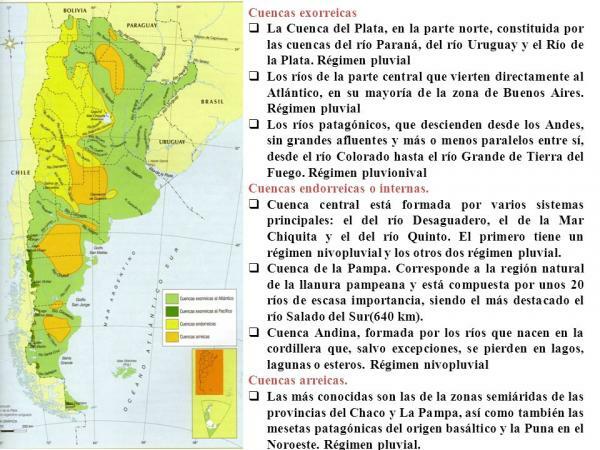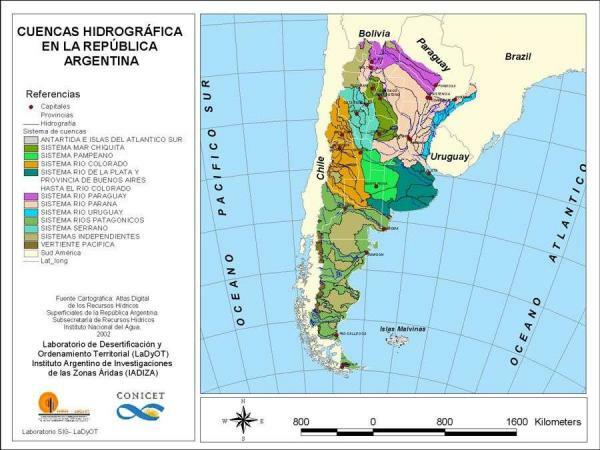Most important rivers of Argentina

Image: Interactive Maps of Didactalia
Argentina is one of the American countries where rivers form an important part of the geography of the territory. As in other states, in Argentina we can also divide rivers by slopesThese being those of the La Plata basin, the Atlantic basin, the Pacific basin, and in which the interior basins are grouped. To know in depth some of these water sources in this lesson from a TEACHER we are going to talk about the most important rivers of Argentina.
The La Plata Basin is a part of Argentina drained by the Río de la Plata and all its tributaries. It is of great global importance, since it is the second largest in all of South America, and the fifth in the world. There are a large number of rivers belonging to this slope, but among all of them we can highlight six. These important rivers of the watershed of the La Plata basin are the following:
- Uruguay River: It is born in the Sierra Geral in Brazil and flows into the Río de la Plata. It has a length of 1,170 kilometers, and the area of its basin is 370,000 km2.
- Parana River: It is born from the confluence of the Grande and Paranaíba rivers and flows into the Río de la Plata after passing through Brazil, Paraguay and Uruguay. Its length is 4880 kilometers, and the area of its basin is 2 582 672 km2.
- Paraguay River: It is born in the Mato Grosso Plateau and flows into the Paraná River, being one of its largest tributaries. It has a length of 2,695 kilometers, and the area of its basin is 1,170,000 km2.
- Pilcomayo River: It is born in the eastern mountain ranges of Bolivia, and flows into the Paraguay River. It has a length of 1,590 kilometers, and the area of its basin is 270,000 km2.
- Bermejo River: It is born in the Santa Victoria mountains and flows into the Paraguay River. It has a length of 1,450 kilometers, and the area of its basin is 123,163 km2.
- Salty river: Also called Salado del Norte, it is born at the confluence of the Arias and Guachipas rivers and flows into the Paraná River. It has a length of 2,355 kilometers, and its basin has an area of 124,199 km2.

To this slope belong all those rivers that flow into the Atlantic Ocean or the Argentine Sea. It is considered the largest slope in the state, so we can find very important rivers in this area. Some of the largest rivers in this area are the following:
- Colorado River: It is born in the Andes Mountains and flows into the Argentine Sea. It is 1,114 kilometers long, and its basin has an area of 350,000 km2.
- Desaguadero River: It is born in the Frontal and Principal mountain range and empties into the Colorado River. It has a length of 1,480 kilometers, and the area of its basin is 260,000 km2.
- Black river: It is born from the confluence of the Limay and Neuquén rivers and flows into the Argentine Sea. It is 635 kilometers long, and its basin has a surface area of 132,275 km2.
- Chubut River: It is born in the Cerro de las Carreras and empties into the Atlantic Ocean. It has a length of 810 kilometers, and the surface of its basin has 53,801 km2.
- Desired River: Its birth takes place in Lake Buenos Aires and its end happens in the Atlantic Ocean. It is 615 kilometers long, and the area of its basin exceeds 14,000 km2.

Image: SlidePlayer
To continue with this lesson on the most important rivers of Argentina, we must talk about all those rivers that flow into the basins of the interior of the Argentine state. The most important rivers on this slope are not too long, but it is important to know them. Some of these rivers are the following:
- Abaucán River: Also called Colorado, Salado or Bermejo, this river is born at the confluence of the Fiambalá and Chaschuil rivers, and empties into the drains of the Salado river.
- Suquía River: Also called Primero because it was the first mighty river that the Spanish found. It is born in Lago San Roque and flows into the Mar Chiquita. It has a length of about 200 kilometers and its basin is endorheic.
- Sweet River: It is a river with a length of 812 kilometers, which is born in the Hondo river reservoir and flows into the Laguna del Mar Chiquita.
The rivers of the Pacific slope are all those that flow into the Pacific Ocean, passing all of them through Chile. They are characterized by passing through both Argentina and Chile, and for being small rivers as a general rule. Some of the main rivers of this slope are the following:
- Hua-Hum River: This river is born in Lake Nonthue and flows into Lake Pirehueico. It has a length of 17 kilometers, and its basin has an area of 1,150 km2.
- Puelo River: It is born in Lake Puelo and empties into the Pacific Ocean. It has a length of 120 kilometers, and the surface of its basin is about 8,800 km2.
- Futaleufú River: It is born in the Amutui Quimey reservoir and flows into Lake Yelcho to later end in the Pacific. It has a length of 246 kilometers, and its basin an area of 6,929 km2.
- Carrenleufú River: It is born in General Vintter Lake and empties into the Pacific Ocean. It has a length of 240 kilometers and its basin an area of 12,887 km2.

Image: History and biographies

